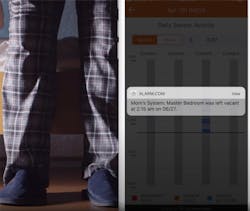COVID-19 is keeping all of us isolated in homes, in hospitals and in senior living communities, and social distancing makes it hard for people to connect with or care for their loved ones, especially those in need of assistance. It seems that even when restrictions on in-person visits are lifted, this global health crisis has awakened the world to a problem that needs solving for millions of people worldwide.
Modern security technology offers compelling new ways to enable care and connection; however, the average consumer simply is not aware of these capabilities. The opportunity is there for security service providers to make a positive difference right now and prepare us for the future.
Start by making your solutions personal and family-centric. Shift messaging more towards “connected living” rather than “intrusion prevention” to help get current and potential customers thinking about the people who matter most. Here are a few solutions to consider:
Video with Two-Way Audio: Smart camera solutions featuring two-way audio are one way to keep families connected while social distancing. Customers can – using products such as Alarm.com’s Wellcam – create an individual connection or give up to 10 family members access to a camera. A push-to-talk button enables families to look in on and speak to isolated family members in other locations. A highlight reel of images from the day can be captured and shared, and the Wellcam, in particular, can activate a direct call to family members with the push of its call button like a typical PERS device.
Door/contact sensors. Noting when loved ones come and go, as well as when they eat, shower and take medicine, is important for caregivers. Adding sensors to exterior doors is like having a virtual front desk in the home, alerting family members when someone exits and enters, including scheduled homecare visits, deliveries or services. Putting them on the refrigerator, shower and medicine cabinet/pill box is a great way to track if loved ones are eating and taking medications regularly and practicing proper hygiene. All can be indicators of potential issues if habits change.
Bed/chair sensors. Proper sleep habits and exercise are important to sustained health. An occupancy sensor placed under a mattress and chair cushion helps families stay on top of their loved one’s daily and bedtime routines. Are they spending long periods in their chair each day or are only in bed for a few hours each night? These sensors can provide clues to help identify increasingly sedentary lifestyles or nighttime safety issues that can be unhealthy.
Motion detectors. Like the bed and chair sensors, motion detectors installed around the home can provide a summary of daily activity.
A simple yet effective Connected Living kit combines motion detectors with occupancy and/or contact sensors. One benefit these solutions have in common is that each one is essentially ready-made for professionally guided installations that do not require entering a customer’s home; in fact, Alarm.com has launched a resource center to help assist integrators with guided installations and other critical tasks during this time.
Finally, do not overlook the value of intelligence when it comes to the health and safety of customers and their loved ones. Machine learning is able to recognize unusual events or deviations from normal routines, notifying family members and caregivers of potential problems to accelerate early intervention.
Steve Chazin is VP of Product Management for Alarm.com. Request more info about the company at www.securityinfowatch.com/10216128.
About the Author
Steve Chazin
Steve Chazin is VP of Product Management for Alarm.com. Request more info about the company at www.securityinfowatch.com/10216128.
